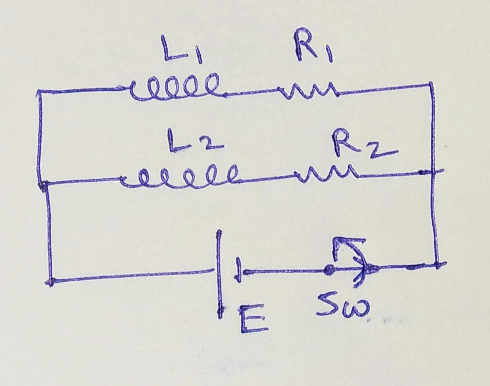To explain my question, I wish to use the case as shown above. I am able to solve the numerical based on the above and similar cases, but still, I have a conceptual doubt regarding the workings of an Inductor.
Suppose in the case above, the battery is connected for a very long time and a steady-state is reached in the circuit. Two steady but different currents will be flowing through the two inductors, in the two branches. Now suppose, suddenly the switch adjacent to the battery is opened up. Now my doubts come into the picture:
We know that the inductor doesn't allow the instantaneous change of current and flux through it, so the currents in L1 and L2 should remain the same immediately after the switch is opened up, but that is also not possible as the direction of current in the loop containing L1 and L2 cannot be in the same direction, so we reach to a contradiction. How do we resolve this conflict?
In the solution to this question, textbooks apply something called "Flux Conservation" inside the remaining loop (which is left after the switched is opened up). They say that the flux through the loop containing L1, R1, L2, R2 should remain the same immediately before and after the switch is opened up. That helps us proceed and gives us some answer, but what is the conceptual basis of doing such a thing like "Flux Conservation" in the remaining loop? Why are we doing it and what is the theory behind it? Shouldn't the flux and thus the current remain conserved in both the inductors individually instead of the remaining loop? But if we assume that then that also leads to the problem I mentioned in Point 1.
Even if we assume that the point 2 is right and we can apply "Flux Conservation" "inside" the remaining loop, then why are we not conserving the flux "outside" the loop in the rest of the space in the universe? Why are we conserving the flux only "inside" the loop? What is so special about the "inside"?
As I understand the conceptual basis of Electromagnetic Induction (EMI) is something called "Electromagnetic Inertia". Fields like Electric and Magnetic Fields have certain inertia in them, due to which they do not allow the sudden change in themselves, which in turn leads to the effects of Electromagnetic Induction. If this understanding of EMI is right then the flux should not change inside and outside the loop in a "dt" time, but when we apply flux conservation only inside the loop then only we get the right answer.
All the thoughts above have challenged my existing understanding of EMI and Inductors. I request you to kindly help me untangle my conflicting thoughts and help me going in the right direction.
For the sake of further explaining my question, I have taken a sample problem based on the concept above, which is shown below.
The lecture corresponding to this problem can be found on the following link. https://www.youtube.com/watch?v=6MLgZIPG8i0



